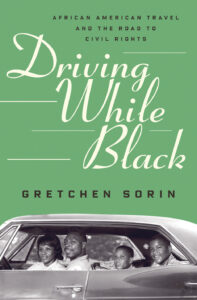NAACP Membership:
It’s Not About Color
By Monica Calzolari

I just joined the Oneonta Chapter of the National Association for the Advancement of Colored People after hearing Professor Gretchen Sorin speak about her book and documentary film by the same name, “Driving While Black.”
I joined because I support equality and I was appalled by what I learned during her presentation at SUNY Oneonta’s Center for Racial Justice and Inclusive Excellence on October 13.
Although I am painfully aware that white supremacy exists and that George Floyd and many other African Americans have been murdered, it hit me on a deeper level that this country used to be even more blatantly discriminatory.
In her documentary film, Sorin captures how the automobile represented profound personal freedom to people of color. Clips from the film allowed me to put myself in the shoes of my fellow Americans and realize how dangerous it was for African Americans to even drive through many parts of the United States. They encountered such hostility that they had to sleep in their cars and eat food they had packed in coolers because they were not welcome in the white hotels and restaurants as recently as 1964.
I also learned there were certain towns where blacks were prohibited after sundown. Cooperstown was one of those sundown towns!
Have you ever heard of the “Green Book”? I hadn’t. “The Negro Motorist Green Book” was named after Victor Green.
Sorin educated us that Mr. Green and his wife, Elma, published travel guides between 1933-1966 detailing where it was safe for people of color to eat, pump gas, go to church and even to the barber shop.
Prior to 1964 when Lyndon Johnson signed the Civil Rights Act into law, there were white banks and white funeral homes, black banks and black funeral homes. There were colored motels, colored restaurants, colored grocery stores, and beaches where colored people congregated.
The “Green Book” was a road map that documented safe havens for people with dark skin. This NAACP-sponsored presentation taught me how cruel and blatantly discriminatory the United States was less than 60 years ago. To think that these conditions existed in my lifetime and that these deeply ingrained prejudices still exist today is frightening.
I have noticed how few people of color live in this area. I am happy that Sorin’s topic attracted more than 100 participants, including many students. Although I consider myself well-educated, I never learned the truth about this part of history. These details were not reported in the U.S. history books I studied.
I hope readers of “Hometown Oneonta” will watch the two-hour film Sorin produced with the help of Ric Burns. It is eye opening and crucial to truly understanding the meaning of popular buzzwords like “diversity” and “inclusion.”
I am grateful that Henry Ford hired people of color, which allowed them the opportunity to buy cars and gain social mobility. I can only imagine how exhilarating a car would be compared to having to sit at the back of the bus or on a train car designated for colored people.
The National Association for the Advancement of Colored People is still sorely needed in this country. I look forward to future events to raise my own awareness at www.oneontanaacp.com/


It does amaze me when I realize that most of our population in the US today does not realize how horribly racist our country was as recently as the 1960s when I was a child. In my white town on Long Island, it took a bitter battle to pass a new open housing law before black people could buy homes there. When the first black family moved in, a cross was burned on their lawn. My friends’ parents spoke openly in the most derogatory terms imaginable about all black people, considering them ugly, stupid and subhuman. The South was even worse than the North. The history and legacy of extreme racism is a sin of monstrous proportions.
It does amaze me when I realize that most of our population in the US today does not realize how horribly racist our country was as recently as the 1960s when I was a child. In my white town on Long Island, it took a bitter battle to pass a new open housing law before black people could buy homes there. When the first black family moved in, a cross was burned on their lawn. My friends’ parents spoke openly in the most derogatory terms imaginable about all black people, considering them ugly, stupid and subhuman. The South was even worse than the North. The history and legacy of extreme racism is a sin of monstrous proportions.
As a white person who has been an active NAACPer since 1962 I commend your decision. White members are welcome but sometimes they come in to a group of veterans in the struggle and act like they have all the answers. It is a time to be humble and learn and you will find areas where you can effectively serve in the struggle against white racism
As a white person who has been an active NAACPer since 1962 I commend your decision. White members are welcome but sometimes they come in to a group of veterans in the struggle and act like they have all the answers. It is a time to be humble and learn and you will find areas where you can effectively serve in the struggle against white racism